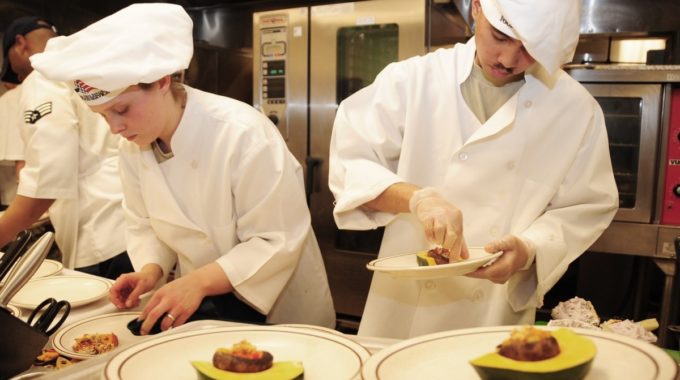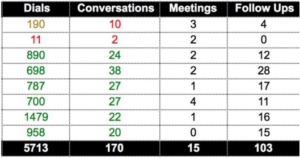
Part 1: Quality vs. Quantity vs. Nothingness
If you follow my posts on LinkedIn, you may have noticed that I publish the stats of our top-of-the-funnel team — in the common tongue, our Sales Development people. Here’s an example from Wednesday, vernal equinox week, 2017:
I have enjoyed reading and responding to the many comments, which fall into three themes:
- “Wow/cool/way to go/keep it up/I’ll have what she’s (or he’s) having.”
- “Are you running a sweatshop over there? Put the whip down, brother!”
- “Ah — big numbers. These conversations must suck! Slow down!”
I’m going to leave 1 and 2 alone for the moment, although I’m sure we’d all like to have what she, or he, is having. It looks pretty fun to talk to 24 people, or 27, or 38 in a day. And even if you only talk to 2 people in 10 minutes and reschedule 2 meetings, that’s not too shabby either, depending on how you feel about making tens of thousands of dollars an hour.
Let’s pull out our quality shovels and dig into number 3. Lots of conversations must mean lots of lousy conversations, right? After all, everybody knows there’s a quantity-versus-quality trade-off in everything we do.
You don’t know beans — or at least not these beans
For dinner in Edinburgh, if I want quality, do I stop at McDonald’s or stroll over to the restaurant called “21212” and watch the chefs foam the inside of a lima bean with liquid nitrogen, turning nothingness into deliciousness? If I have just robbed a bank, I do the latter. Of course, if my constraint is money, or time, it’s McDonald’s. (Do you know how long it takes to foam the inside of a lima bean? Trust me, “while we’re young!” was never so close to my lips, except my lips were happily involved with my whisky glass.) If my constraint is perfection and being treated like the most special little eater in the world, off to 21212 with me!
So, when we think “quality,” we think “hand-crafted,” “one at a time,” “expert,” and “slow,” with a “human touch.” Sure, Japanese car manufacturers proved to the world that quality can be delivered fast, at scale, but that takes things like “thinking” and “discipline” and “continuous improvement” — so, we’ll stick to the usual “give me that slow home-cooking” view of quality for the moment.
But a question remains, one that I’m sure has not crossed your mind. Would we give the chefs (and there are scads of them, working in teams) at 21212 more credit for quality if they took a lot longer to get to work every day?
The quality of commuting is not strained
Say we have two chefs on the 21212 team. They have equal skill. They are equally fun to watch hunched over a lima bean as though it were having a heart attack. The only difference is this:
- Chef Andrew walks to work every day. It takes him about 1 hour and 42 minutes. He sometimes stops to gaze at Edinburgh Castle. Somehow, he never tires of the sight of it, especially on fine summer afternoons when there’s a gentle breeze and the sky is as blue as a robin’s egg. (And why don’t we put those on the menu, Chef Andrew sometimes thinks.)
- Chef Alicia takes the train — right past the McDonald’s at Asda Chesser Supercentre without a moment’s thought. Chef Alicia likes to read, and not just about liquid nitrogen and lima beans. She does look out at the lovely scenery and occasionally wonder how people live in sad, distant places like California — but wouldn’t you? Her commute, including the stroll to Sighthill station, the ride to Leopold Place, and the 3-minute walk to “the office” takes about 46 minutes. Very pleasant minutes, but minutes nonetheless.
Here’s the question: Who is the better chef? Chef Andrew or Chef Alicia? Can you tell this just by comparing how long their commutes take? Are Chef Andrew’s foamed lima beans 2.2 times better than Chef Alicia’s because his commute is 2.2 times longer than hers?
Of course not. You might favor walking, or you might be a rabid train fan, but I think we all know that taking longer to commute to work doesn’t make us better at our jobs. Chef Andrew may be more fit from his daily walk — although Chef Alicia does take very long, strenuous bike rides on days off, and she hits The Gym on Waterloo Place every night after work — so don’t you be jumping to conclusions about that either!
Now, let’s put our forks down for a moment and consider telephone-based sales. You know — something that’s harder than foaming the guts of a lima bean and scarier than a liquid nitrogen spill. And we’ll ask the same question…in Part 2 of this blog. Stay tuned!

